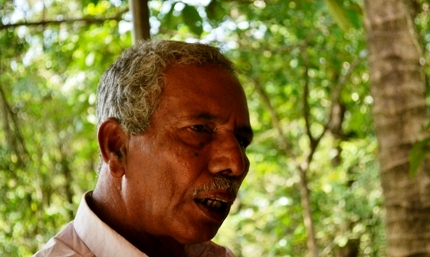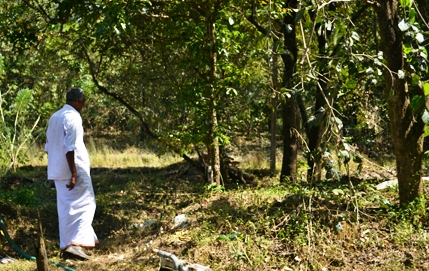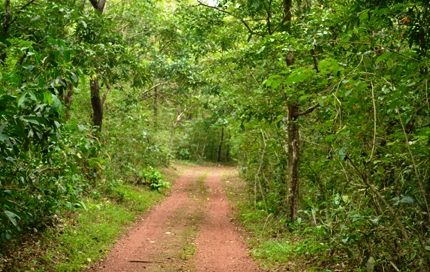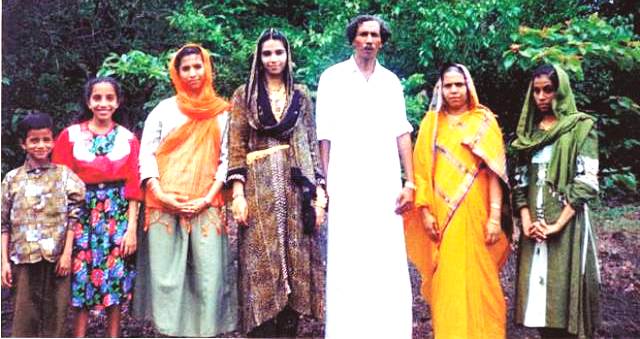The Story of Kareem and the Forest He Created

This is an enviable saga of a single man’s continuous hard work and dedication to bring about great changes in the lives of a village in North Kerala. He created a 32-acre forest in a barren rocky wasteland, a sheer environmental miracle now acknowledged worldwide. It has bettered the climate of the place, improved the standard of living, and served and saved the lives of many animals, birds and reptiles. MUHAMMED NOUSHAD meets him in the forest he created and writes. Photographs by VM SADIQUE ALI.
Abdul Kareem has been allured by miracles since his childhood. His birthplace, a small village called Kottappuram near Nileswaram in Kerala’s northernmost district Kasargaode, gave him ample opportunities to stand in awe at the endless splendors of nature. His young foot followed the movements of butterflies and dragonflies and birds as far as possible. He never grew tired looking at the river or standing on a hill top. The stars in the sky gave his mind a natural invitation to contemplation. While he was a student in Nileswaram Raja’s High School, he used to lose himself in a local sacred forest called Mannamburathu Kaavu, during lunch hours. The indigenous wisdom of leaving a piece of land, with a spirit of sacredness, untouched by human intervention and letting all trees and plants grow there had a very deep impact on his mind. Its organic serenity and blissful calmness embraced his soul, at the very young age. The boy intuitively knew that this natural habitat, this miniature of forest, could help men and women regain what they have lost in the midst of progress and development. His village and its kaavu, with their warmth and a call to innocence, accompanied him wherever he went.
He gradually found it difficult to live in big cities. The smell of air conditioners slowly started irritating his nostrils. The innumerable kinds of pollutions implanted in his mind a strong aversion for cities. The call back to nature, back to its wilderness and peacefulness, has always been there in him, through the constantly reminding innocence of the Mannamburathu kaavu. He decided to leave urban life in 1977 and came back to his village to work a miracle, with the nature. There begins the real story of an otherwise typical travel agent cum business man turning first into “an eccentric” and later “an environmental miracle worker”.
Kareem’s Forest: Growth of a Wild Dream
Kareem’s forest is now globally acknowledged as an environmental miracle. These 32 acres of man-made forest have inspired thousands of people around the world – from the local school children to India’s largest oil company, as the Indian Oil Corporation chose to give him a petrol pump in 2004 during its “India Inspired Project”.
At the early stage, what Kareem tried to do was taken as an awfully eccentric act by almost everyone in the vicinity. Some even termed him lunatic. No ordinary man would ever attempt such an adventure, you would think seeing the kind of hard laterate rock upon which he grew his saplings. It would require very deep dedication, matchless hard work and enviable faith in God. He first purchased five acres of land in Puliyamkulam, near Parappa, his native village, and built a small house. Surrounding it, in a barren and desert-like land, he started growing trees and wild saplings. What he thought was to make a kaavu over there; he remembers with utmost honesty that making a forest was least in his intention. He wanted a naturally peaceful place for him and his family to live. He had never been exposed to any kind of city-style environmental activism, nor participated in any eco-sensitisation drives. His rural soul has had the idea deep inside. This realization of the need for an organic setting to be in perfect harmony with nature, was strongly in contrast to even his friends making profits by rampantly mining rock in the surrounding areas. Kareem attempted this “misadventure” in the middle of people who mindlessly executive selective felling and clear felling of wild trees to make plantations, particularly cashew nut and rubber. He believed, it is anti-natural and hence anti-human and thus anti-God. His worldview was not anthropocentric any longer as he gave equal space and dignity to wild animals and birds and ants and earthworms alike.
Right now, when you stand in Kareem’s forest, you can feel that this patch of lush green wilderness in the middle of a vast barren land is cool in all seasons. It is dark in the noon, the forest being so dense and richly bio-diverse. Once, this piece of land was also aridly dry. You feel like you are in a naturally grown forest. One of the best man-made forests ever. No signboard, no security guard, no fencing, no watchdog. The only instruction that is strictly followed is of prohibiting plastic inside.
It is important to note that it took nearly three years for Kareem to get the first sapling take roots in the soil. His commitment and hard work is legendary. He would spend his hard-earned money to purchase wild saplings from Bhimanadi nursery of the Kerala forest department and plant them across his five acre land. The summer would keep being merciless on his plants; he would try again and again, and the summer would thrash them down again and again. At last, he would find one Vaaka (Gulmohar) sapling struggling to survive through the hard rocks. Having his faith been reassured, he would smile a deeply courageous and endlessly hopeful smile. As if in a prayer.
He had many reasons to stop this ‘misadventure’, though he did not. In the process of this untrained and unheard of aforestation drive, he had easily become a laughing stock in his village. In the summer, he fetched water from a source a kilometer away on a bike, in small cans, with the help of labourers. People doubted if this man watering the saplings planted on rocks was really sane. The fate of wisdom has always been in dubious positions, he consoled himself. He dug a well there and found no water. The temperature was high. The soil was unyielding. He thought of conserving rainwater for his trees and invented his own methods to preserve it. The money he earned through decades-long hard work in cities like Bombay and Dubai was getting spent on the fulfillment of an impossible dream. To the complete bewilderment of his family and friends, he further purchased 27 acres of rocky slope in the same place, and expanded his “eccentric” experiments further.
But, nature was eventually kind to Kareem. It always is, to everyone who is patient. His choice of the pioneer species was effective and fitting to the character of the soil. He set up water spots in the land and attracted birds from faraway places in different seasons. They would bring seeds that would make the secondary species of the forest in a later stage. However, Kareem found a few saplings taking roots and new leaves shooting up. He also sighted water in the well as he had deepened it. He was elated and excited, started planting as many species as possible. He knew that nature would do the rest if you give its due. His idea of creating a forest has never been planting as many trees as possible. He looked for a perfect symbiosis of all possible species. The magic had already begun. Now, people call it a miracle.
Today, when you stand in Kareem’s forest, you realize what an incredibly miraculous story his is. His forest is very calm, silent and spiritual. A great example of man’s strength and nature’s mercy. Reciprocity and symbiosis. Abdul Kareem leads you through the trees and shows you his proud achievements. A very talkative villager, he shares his concerns on the kind of degradation human beings do on the nature in the name of development. Despite the umpteen awards and accolades he received, he was not tempted when the government proposed him to carry out certain projects like Ayurveda College and some other commercial projects in plots adjacent to his forest. This self-taught man was wise enough to see beyond those ambitious projects. His forest is still growing as the birds come and invest seeds of new plants.
There are innumerable animals and birds and moths in Kareem’s forest. Fowl, foxes, snakes, birds and many small animals inhibit there. He has dug four wells and four ponds in the land. All big and full of water. His rainwater preservation is unique. He dug catch pits and raised tiny walls with rock pieces across the slop. The soil carried by the flowing water started gradually getting deposited over rocks. He studied the sloped structure and divided the land for easy absorption of the water to the soil. Canals collected the remaining water and they flew through the forest. In years, canals became natural streams. Today, in summer, many villagers collect water from his tanks whenever the local administration’s water supply fails. He can pump more than 100,000 liters of water and the water level would remain intact. Remember, this happened in a place where there was acute water shortage even to give life to a dying plant some decades ago. The villagers have learned the lesson. Kareem claims he and his family do not usually get afflicted by diseases as they use water that the forest gives. The presence of innumerable medicinal plants, some rare species included, must be giving his water some natural healing powers. The forest is rich in bio-diversity, with around 800 species of trees and 300 species of medicinal plants.
The climate he changed with his forest
Establishing a forest ecosystem in a hard lateritic wasteland has had a lasting impact on the climate of the place, too. Thirty seven years back, this dense forest was a rocky waste land, with no water around, and in highly unsuitable conditions for habitation. Now, the temperature in soaring summer never crosses 31 degree here, whereas in the same days, Kozhikode city shows the temperature of 41 degree. The rainfall has also increased to 340 millimeter. When there is no rain in Parappa or other nearby places, Kareem’s forest and the surrounding valley get rain.
Water table levels in nearby villages within a radius of 10 km, like Kaliyanam, Varranjnyur and others rose considerably. The once barren hill slowly became a water sponge. The villagers who mocked at Kareem for his eccentricity later realized the depth and magnitude of his service. His forest could be taken as a model for a feasible drinking water supply scheme for drought affected areas. It is cost-effective and sustainable, despite the time it takes.
The best thing perhaps about his mostly deciduous forest is the way he uses the humus. Thick layers of leaves are allowed to decompose naturally and they turn the rock into soil, in effect, by rapidly increasing the fertility. This man’s wisdom, common sense and hard work are exemplary. He cuts his trees whenever there is a need and adopts scientific means to stop wildfire. Our official aforestration drives have many things to learn from here.
A man of philanthropic missions, he never gets any threat to his forest from his villagers. They are also part of the forest in many ways. That may be the reason he hasn’t felt the need to build a fence to guard it. He had been instrumental in bringing the first bus service to this remote village. He has helped his poor Dalit friends in the village by building houses for them.
Kareem’s philosophy is simple. Deeply religious, he believes in deeds, not in words. He often infuriates media persons by refusing interviews. “I am not interested in what you write about me. I would be rather happy if you plant some trees,” he says. In fact, he has inspired many across the world. In India, many universities and research institutes have studied his modus operandi in forest conservation and regeneration. The Kerala state educational board, SCERT, has included a chapter on him for the sixth standard students. Trinity College, Hard Ford Connecticut, USA, selected his forest for the research of the relation between plants and religion; he has given a telephone lecture for the scholars over there. Thousands of school children and scores of university students have visited his forest, which serves as an informal center of learning. In the context of global warming and its imminent threats, Kareem is a ray of hope.
[This study was conducted with the assistance of Bangalore based Pipal Tree Foundation’s Climate Change Fellowship programme and Interactive website carried it in July 2014.]




This is a truly inspirational story, thank you for writing it. It shows that if we are good to nature, nature will be good to us. It also shows that with hard work and dedication, we can reverse the devastation we’ve created.
Reblogged this on The Jaguar and commented:
I realize this post is a little off topic for this blog. It is not about big cats, nor does it concern human-wildlife conflict.
Instead, it is about what can happen when we take care of our environment. Kareem has shown the world that if we give it a chance, nature can rebound with a vigor that is nothing short of miraculous. When it does, the people who rely on that ecosystem will benefit as well.
In this age of climate change and extinction, it is easy to lose hope. Kareem’s story serves as a reminder that despair is never warranted. If one man’s efforts and determination achieved such incredible results, imagine what whole communities can accomplish.
Found this thanks to Josh and agree it is an inspirational story of hard and persistent work to create a real change.
Thank you dear ones. Kareem can be contacted at kareemforest@yahoo.com.
Thanks for sharing this, we really need to know about such wonderful people and their efforts.